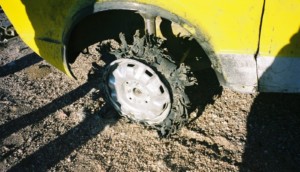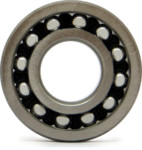
In the last few posts I went in detail through the eight pillars of Total Productive Maintenance (TPM). However, looking at this framework of eight pillars, besides having a few pillars too many, I am sorely missing one very important pillar: Reactive Maintenance! How do you fix stuff after it breaks? If I create a structured approach for maintenance, reactive maintenance would be one of the key points, yet it is completely absent in the TPM framework. This is in my opinion one of the flaws of TPM. I am looking forward to receiving your responses or rebuttals. I am sure I will learn more about maintenance through your comments. In any case, let me explain my view.
I also will go a bit into when to do reactive and when to do preventive maintenance. In my next post I will go into greater detail on how to do reactive maintenance.
Preventive vs. Reactive Maintenance

Preventive maintenance tries to fix a problem before it becomes a problem. Reactive maintenance (often called corrective maintenance) fixes the problem only after the fact. The advantage of preventive maintenance is that the problem will be much smaller or nonexistent, whereas reactive maintenance usually has many expensive follow-up problems like delays, missed deadlines, cost of spare parts, or injured people. The advantage of reactive maintenance is that you have a much better understanding of the problem, whereas preventive maintenance is often based on guesswork with anecdotal evidence. In sum, with reactive maintenance you see exactly what your money does, but it can be much more costly than preventive maintenance where it is unclear which expense is actually beneficial.
Originally, reactive maintenance was part of TPM. But somewhere along the line, this got dropped. Most TPM frameworks don’t mention corrective maintenance, and then often only in a historical context. I have yet to find an example of the eight (more or less) pillars of TPM that include reactive maintenance. When googling, there are over 600 000 results for preventive maintenance, but only 150 000 results for reactive or corrective maintenance.
 I think the underlying idea of TPM is that with enough preventive maintenance you no longer need reactive maintenance. However, I believe this is absurd. Reactive maintenance is as important as preventive maintenance (or even more so). I have yet to see a factory that had no breakdowns. In some factories reactive maintenance is even more common than the preventive maintenance. Even with an insane amount of maintenance, you will still have breakdowns, just fewer of them (hopefully). Even in this case, excessive preventive maintenance may be more expensive than the problems arising from a breakdown. Granted, most companies are still quite a bit away from too much preventive maintenance, but all companies I known still do reactive maintenance on a regular basis.
I think the underlying idea of TPM is that with enough preventive maintenance you no longer need reactive maintenance. However, I believe this is absurd. Reactive maintenance is as important as preventive maintenance (or even more so). I have yet to see a factory that had no breakdowns. In some factories reactive maintenance is even more common than the preventive maintenance. Even with an insane amount of maintenance, you will still have breakdowns, just fewer of them (hopefully). Even in this case, excessive preventive maintenance may be more expensive than the problems arising from a breakdown. Granted, most companies are still quite a bit away from too much preventive maintenance, but all companies I known still do reactive maintenance on a regular basis.
 Hence, for me reactive maintenance is an important part of maintenance, and would fully justify its own column in the house of TPM. I agree, it is not a sexy pillar. When selling maintenance services, the idea of not having any breakdowns sells much better than what to do after a breakdown. Plus, the service provider will have long been paid before the company finds out what kind of difference the preventive maintenance actually made. In terms of the PDCA, the Check and Act may happen only years later, if it is done at all.
Hence, for me reactive maintenance is an important part of maintenance, and would fully justify its own column in the house of TPM. I agree, it is not a sexy pillar. When selling maintenance services, the idea of not having any breakdowns sells much better than what to do after a breakdown. Plus, the service provider will have long been paid before the company finds out what kind of difference the preventive maintenance actually made. In terms of the PDCA, the Check and Act may happen only years later, if it is done at all.
But on the shop floor, what to do after a breakdown is often a big issue, and there is also often lots of potential to improve preventive maintenance. I find it important to provide guidance here too, even though it does not sell as well, and the factory is much quicker in finding out if it was worth it. Hence I am strongly in favor of including reactive maintenance as part of the pillars of TPM. In my next post I would like to go deeper into how to do reactive maintenance. But before that, a little bit about when to do predictive maintenance and when to do reactive maintenance.
How Much Preventive and How Much Reactive Maintenance?
 The more preventive maintenance you do, the less reactive maintenance you will need. The big question is: What is a sensible amount of preventive maintenance? Having one reactive maintenance is usually more expensive overall than one preventive maintenance. However, you need many more preventive maintenance events, and it is unclear how many reactive maintenance events were prevented through preventive maintenance. Like with your car, an oil change is cheaper than a new engine, but you need multiple oil changes, and it is unclear how many broken engines this prevents.
The more preventive maintenance you do, the less reactive maintenance you will need. The big question is: What is a sensible amount of preventive maintenance? Having one reactive maintenance is usually more expensive overall than one preventive maintenance. However, you need many more preventive maintenance events, and it is unclear how many reactive maintenance events were prevented through preventive maintenance. Like with your car, an oil change is cheaper than a new engine, but you need multiple oil changes, and it is unclear how many broken engines this prevents.
 Hence, in theory where you just can assume numbers, it is possible to do a cost-benefit analysis. In reality, you are missing a lot of numbers, and even an estimate on the frequency of breakdowns is at best a wild guess. You have no other option but to guess and hope that it will work out.
Hence, in theory where you just can assume numbers, it is possible to do a cost-benefit analysis. In reality, you are missing a lot of numbers, and even an estimate on the frequency of breakdowns is at best a wild guess. You have no other option but to guess and hope that it will work out.
In literature, it is often recommended that the goal should be 80% preventive maintenance and 20% reactive maintenance. I haven’t found any scientific proof for this, but my gut feeling tells me that this number is probably not too far off. In reality, however, you will find that typical maintenance departments often do 30% to 50% reactive maintenance. It is also a gut feeling that many companies could benefit from more preventive maintenance, but it is really tough to make such a statement for an individual company.
 Although on one aspect I am certain: If preventive maintenance can prevent injuries, then you should do it! Authorities in charge of the road or rail networks often have a “budget” for every potential life saved. In advanced countries this is often around $1 million. The authorities are willing to spend $1 million to save one life. Hence, with respect to possible injuries, you should very much err on the side of safety.
Although on one aspect I am certain: If preventive maintenance can prevent injuries, then you should do it! Authorities in charge of the road or rail networks often have a “budget” for every potential life saved. In advanced countries this is often around $1 million. The authorities are willing to spend $1 million to save one life. Hence, with respect to possible injuries, you should very much err on the side of safety.
 Preventive maintenance is often just guesswork, but predictive maintenance can help by collecting data and estimating when an item will break or if it will break soon. This is also related to industry 4.0. For example, a sensor could measure the vibrations of a bearing. If the system detects an increase in vibration, it may be time to exchange the bearing before it fails (at an inconvenient time with higher follow-up cost). There are lots of possibilities, but unfortunately they are also not free, which makes the cost-benefit analysis between predictive and and reactive maintenance still difficult.
Preventive maintenance is often just guesswork, but predictive maintenance can help by collecting data and estimating when an item will break or if it will break soon. This is also related to industry 4.0. For example, a sensor could measure the vibrations of a bearing. If the system detects an increase in vibration, it may be time to exchange the bearing before it fails (at an inconvenient time with higher follow-up cost). There are lots of possibilities, but unfortunately they are also not free, which makes the cost-benefit analysis between predictive and and reactive maintenance still difficult.
In any case, try to get a good balance between preventive and reactive maintenance. Only in weak companies is reactive maintenance the default. In my next post I will go deeper into how to do reactive maintenance. Now go out, understand your system better in order to maintain it, and organize your industry!
Series Overview
- A Brief History of Maintenance
- What Are the Goals of Maintenance?
- An Overview of the Eight Pillars of Total Productive Maintenance
- The Pillars of TPM – Focused Improvement
- The Pillars of TPM – Autonomous Maintenance
- The Pillars of TPM – Planned Maintenance
- The Pillars of TPM – Early Equipment Management
- The Pillars of TPM – Quality, Training, Administration, and Safety
- The Pillars of TPM – The Missing Pillar Reactive Maintenance?

I fully agree with you. How much ever one tries to do proactive maintenance , there will be some surprises which calls for reactive/breakdown maintenance. Also it is a trade off between preventive and reactive maintenance considering time and resources required for each of the strategy and prioritization of machines in value stream. Preventive maintenance has two aspects….Inspection and Correction. Effectiveness of these activities results in less or more breakdowns. There has to be holistic approach for reducing breakdown maintenance especially in case of critical and bottleneck machines. Also there has to be timely intervention by the concerned for overhaul/up-gradation of machines to upkeep health of machine from time to time. Replacement of modules is another strategy to optimize MTTR and MTBF. It is good to measure/track various KPIs like no. of hours spent, maintenance cost etc.. for breakdowns vs planned maintenance and fine tune/optimise the maintenance strategies over a period of time. Overall there has to be “Life cycle management of Asset” through out its life cycle( in my opinion) to maximise the benefits.
As the popular t-shirt slogan says ‘S**t happens’. And there’s no getting away from that. You need an effective and timely response and that’s kind of hidden amongst many pillars of TPM and this is where it lacks focus. My interpretation is that autonomous maintenance is that, Breakdown Maintenance. Whilst this pillars teaches that handing over minor tasks to operators is desirable to better utilise the time of the maintenance team it still requires them to act in case of breakdown. The reason for doing this in the first place that it is a positive thing to do and gives tangible improvements to business performance, Pillar 1. Of cause autonomous maintenance cannot be actioned with training the operators, Pillar 6. You also need to make sure the work environment you are asking people to operate is safe for them to do so, Pillar 7.
Going right back to the origins of maintainability analysis, Mil-Hdbk-472, diagnosing the issue and fixing the issue is only part of the problem. It means nothing if you can’t get the right people with the right equipment and the right parts to the location of the failed equipment in good time. Hence the US DoD developed a program called Integrated Logistics Support. I rationalise that as what should be the focus for Pillar 8, Office TPM. Optimising the day-to day operation of HR and site facilities offices will have little direct impact on operational availability and FTR.
As you say another major issue with TPM is the avoidance of financial cost calculations for determining what each strategy costs. The iceberg is analogy is again often used to illustrate this. Where as a rule of thumb the hidden cost of ownership is approximately five times the cost of equipment. There are of course more robust way of developing a maintenance strategy based on life cycle cost takes into account depreciation and maintenance costs versus the cost of new equipment, etc.
The maintenance strategy that is hidden amongst the other pillars to a greater extent is condition based or predictive maintenance. Whilst preventive and reaction in case of failure is still required. It seeks to optimise the time that a preventative actions takes place by monitoring the indicator conditions that say something of machine health. This element has been made more attractive and easier by all the elements of 4.0. Including but not limited to; cheaper chip based sensors, communication bandwidth and computer performance. I interpret that it is vaguely covered by a mix of Pillars 1, 4, 5, and 7 (for IT involvement if nothing else).
Hi Jonathan, I think autonomous maintenance and breakdown maintenance are a bit related, but still different pillars. Autonomous is for things the workers can do themselves with a little bit of training. This can include simple fixes. But there are also breakdowns that go beyond the ability of the worker (e.g. I can change a tire at my car, but I can’t change the gearbox).
there are so called maintenance cost curves / graphs (bath tub graphs) to ascertain the optimum level between reactive and pro-active maintenance tasks
https://www.hubhead.com/wp-content/uploads/PM-Graph.png
Hello Professor! Nice post!
When everything goes wrong despite a good TPM and you have a breakdown.
It only remains to follow the BCP (Business Continuity Plan)
In Toyota is normal to review it every 6 month.
Hi Christopher. First of all TPM stands for Total Productive Maintenance. The goal of which is the continuous improvement in equipment effectiveness through small group activity by those that can influence it.
At about half way through the TPM ,master plan journey the road map delivers something called zero breakdowns. As this transition point is approached to maintain progress the targeting switches from preventing breakdown to preventing defects. This is because when stoppages are rare, the goal of never ending improvement is driven by a different kpi. The reason that zero breakdowns is possible is that around 85% of causal factors for breakdowns are due to equipment condition and work routines. That includes around 50% due to human error. These are pretty easily dealt with by suitably engaged front line cross functional teams as part of the day job. Another thing to be aware of is that the pillars are there to guide leadership priorities. This is because the root cause of most failures is management mindset. The pillar steps are a way of directing mindset towards a compelling vision. If you want to achieve reactive maintenance, you don’t need a compelling vision. Just a lack of insight about the shop floor reality.
Hi DAK, the typo productive/preventive was fixed already before your comment, but thanks.
As for the main points, I believe that zero defects is a vision, but in reality this is impossible. You will always have unplanned breakdowns, and will always need reactive maintenance. Investing more in preventive maintenance will reduce this, but even if you invest all your profits in reactive maintenance, you still will have breakdowns. Less breakdowns, but they will still be there … unlike your profit, that is, which will have evaporated after being used up for preventive maintenance. Yes, there is also a possibility of doing too much maintenance, although nobody really knows for sure how much is right. But listening to (some) maintenance consultants endlessly repeating “more maintenance…more maintenance” will eventually put a company over the edge. Although, admittedly, many companies seem to be still quite a bit away from too much preventive maintenance.
If you read my comment I don’t make any claim for zero defects other than it is a necessary shift in outlook as zero breakdowns is approached. Visit any PM prize winner to see that zero breakdowns is very much achievable. Seems like you have made your mind up though so I’m not holding my breath in anticipation.
I think reactive maintenance doesn’t have any system of implementation.
It’s just attend whenever breakdown occur or run to fail if time n cost to correct it is more than desired.
So no need of seperate pillar in TPM.
Be other maintenance procedures we can reduce reactive maintenance but not 100%.
Hello Shantilar, as you said it will be difficult to get reactive maintenance away completely. But since you will have reactive maintenance, it does make sense to prepare for it. It is like a fire department. You don’t want a fire, but if you have one you want experts in firefighting that have the right equipment and training and are optimized for a fast reaction…
Hi guis,
In fact, Reactive Maintenance is part of the TPM. This approach is based on the confidence that the impact of the failure on factory operations (downtime and repair costs, delivery time, safety…) is lower than the investment required for a maintenance program.
On the contrary, unplanned emergency maintenance (breakdown) is unintentional and consists of repairing and replacing broken parts on a “fire fighting” basis.
The danger of this is that “the more intense the fight against fire becomes, the more difficult it is to escape from it.” Urgency overcomes importance. Ongoing efforts to root out problems and implement effective action are repeatedly interrupted or postponed because the “fires” must be extinguished!
Any attempt to maintain equipment systematically and economically will be unsuccessful if it continues to fail regularly, and the intervals between these failures will always change. This makes it impossible to build a reliable and effective maintenance program. We need a system that would allow to establish control over the situation.
The starting point for such a system is to eliminate sporadic breakdowns with a comprehensive deterioration tracking and recovery program. This is where the production and maintenance departments have to play their own additional roles in maintaining and improving the efficiency of the equipment.
The operators must take on the responsibility of sustaining basic equipment conditions and maintaining the correct operating conditions (Autonomous Maintenance).
Meanwhile, the professional maintenance must support the AM program and build a reliable maintenance system to reverse deterioration (TBM), eliminate design weaknesses (Corrective Maintenance) and extend the lifetime of the equipment (CBM) based on the factory strategic priority.
That’s what TPM is about.
The “zero-loss” approach means that we cannot simply aim for “references”, “best in class” or “standards” to set goals. We need to focus on theoretical physical limitation. “Zero loss” thinking contributes to perfection, not perfectionism …
Hi Peter, Reactive maintenance is still important, even though nobody likes it. But my feeling is that TPM often glances over this topic and does not give it its due attention.
Hi Christoph,
Again, what are we talking about? Planned reactive maintenance (run-to-failure) or emergency maintenance (unplanned failure)?
Run-to-Failure strategy is a typical approach for non-critical systems (for example, replacing light bulbs in an office).
On the contrary, the elimination of unplanned failures (breakdowns) is the key TPM strategy to achieve “zero breakdown” .
These are actually quite similar, the only difference is the impact on the operations and hence the urgency. A light bulb needs replacing, but a broken light bulb has less impact than a broken system critical machine. Zero breakdown sounds nice, but is unrealistic. You also want zero accidents, but you would not remove the first aid kits from the shop floor!
This article about reactive maintenance and its role in total productive maintenance was interesting to read. It’s fascinating to me that reactive maintenance isn’t a common practice in the eight pillars of total productive maintenance. Reactive maintenance, as stated in the article, provides a much better understanding of the problem than preventive maintenance, which is frequently based on guesswork. I agree that reactive maintenance is just as important as preventative maintenance, if not more so, because reactive maintenance allows you to see what the problem is and find a solution to fix it. Although preventive maintenance is more appealing, breakdowns are inevitable, which is why reactive maintenance is critical in my opinion.